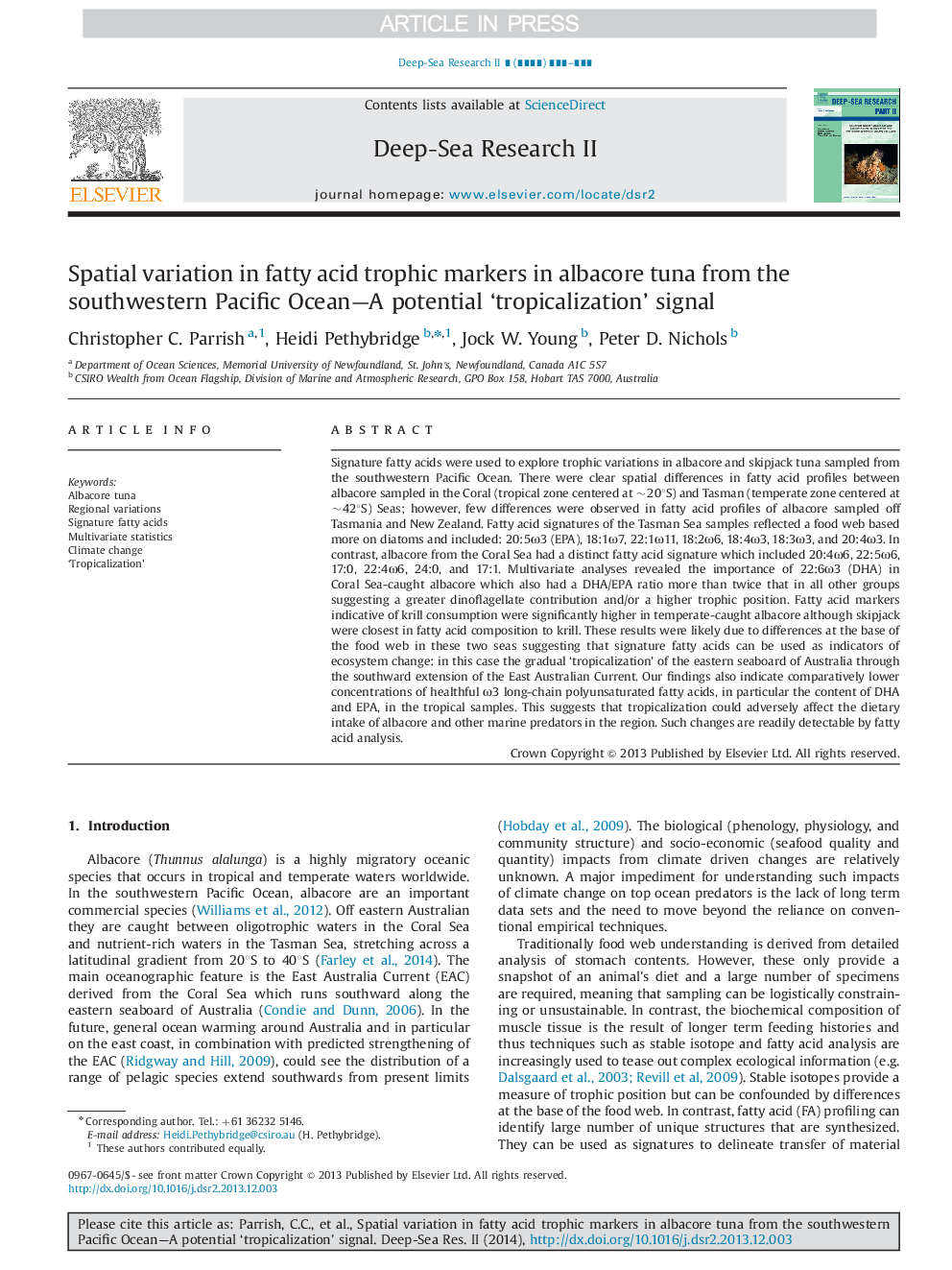| کد مقاله | کد نشریه | سال انتشار | مقاله انگلیسی | نسخه تمام متن |
|---|---|---|---|---|
| 6384128 | 1626427 | 2015 | 9 صفحه PDF | دانلود رایگان |
عنوان انگلیسی مقاله ISI
Spatial variation in fatty acid trophic markers in albacore tuna from the southwestern Pacific Ocean-A potential 'tropicalization' signal
ترجمه فارسی عنوان
تنوع فضایی نشانگرهای تروفیک اسید چرب در تپه گوسفندی از جنوب غربی اقیانوس آرام- سیگنال بالقوه گرمسیری
دانلود مقاله + سفارش ترجمه
دانلود مقاله ISI انگلیسی
رایگان برای ایرانیان
کلمات کلیدی
موضوعات مرتبط
مهندسی و علوم پایه
علوم زمین و سیارات
زمین شناسی
چکیده انگلیسی
Signature fatty acids were used to explore trophic variations in albacore and skipjack tuna sampled from the southwestern Pacific Ocean. There were clear spatial differences in fatty acid profiles between albacore sampled in the Coral (tropical zone centered at ~20°S) and Tasman (temperate zone centered at ~42°S) Seas; however, few differences were observed in fatty acid profiles of albacore sampled off Tasmania and New Zealand. Fatty acid signatures of the Tasman Sea samples reflected a food web based more on diatoms and included: 20:5Ï3 (EPA), 18:1Ï7, 22:1Ï11, 18:2Ï6, 18:4Ï3, 18:3Ï3, and 20:4Ï3. In contrast, albacore from the Coral Sea had a distinct fatty acid signature which included 20:4Ï6, 22:5Ï6, 17:0, 22:4Ï6, 24:0, and 17:1. Multivariate analyses revealed the importance of 22:6Ï3 (DHA) in Coral Sea-caught albacore which also had a DHA/EPA ratio more than twice that in all other groups suggesting a greater dinoflagellate contribution and/or a higher trophic position. Fatty acid markers indicative of krill consumption were significantly higher in temperate-caught albacore although skipjack were closest in fatty acid composition to krill. These results were likely due to differences at the base of the food web in these two seas suggesting that signature fatty acids can be used as indicators of ecosystem change: in this case the gradual 'tropicalization' of the eastern seaboard of Australia through the southward extension of the East Australian Current. Our findings also indicate comparatively lower concentrations of healthful Ï3 long-chain polyunsaturated fatty acids, in particular the content of DHA and EPA, in the tropical samples. This suggests that tropicalization could adversely affect the dietary intake of albacore and other marine predators in the region. Such changes are readily detectable by fatty acid analysis.
ناشر
Database: Elsevier - ScienceDirect (ساینس دایرکت)
Journal: Deep Sea Research Part II: Topical Studies in Oceanography - Volume 113, March 2015, Pages 199-207
Journal: Deep Sea Research Part II: Topical Studies in Oceanography - Volume 113, March 2015, Pages 199-207
نویسندگان
Christopher C. Parrish, Heidi Pethybridge, Jock W. Young, Peter D. Nichols,
